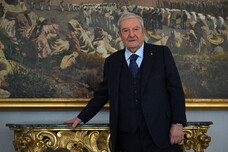Works by greater and lesser-known
Impressionist artists go on display in Rome on Saturday in an
exhibition marking the 150th anniversary of the 19th century art
movement's birth.
Impressionists - The Dawn of Modernity, on show at the
Historical Infantry Museum until July 28, presents over 160
works by 66 artists, including Degas, Manet, Renoir and the
Italian De Nittis.
It is "an exhibition with an unusual, unprecedented angle,
created especially for this exhibition space," said Vincenzo
Sanfo, a member of the scientific committee directed by
controversial art critic and former cultural undersecretary
Vittorio Sgarbi and also including the former director of the
Musée du Petit Palais and Membre Ecole du Louvre, Gilles Chazal,
and the former director of the Musée de Chartres and Musée Paul
Valeéry, Maithé Vallès-Bled.
In particular, the show highlights a little-known aspect of
Impressionist research, dedicated to drawing, engraving and
printing techniques, influenced by the then recent invention of
photography.
Consequently, oil paintings are exhibited alongside preparatory
sketches, studies and lithographs of works well known to the
general public.
The exhibition is divided into three sections collectively
embracing a period that runs from the early 19th century, with
works by Ingres, Corot, Delcroix and Doré, all from private
Italian and French collections, to the heirs of
Toulouse-Lautrec, Permeke, Derain, Dufy and Vlaminck, and ending
in 1968 with an etching by Pablo Picasso.
In it, the little-known works of the great protagonists of the
movement, such as Pissarro, Degas, Cézanne, Sisley, Monet,
Morisot and Renoir, are set alongside 'supporting actors' such
as Bracquemond, Forain, Lepic, Millet, Firmin-Girad and Lecomte.
"Impressionism is not a movement, but a human condition," said
Sgarbi.
"It is life, the possibility of representing states of mind,
this is what the exhibition is all about.
And to hold it here is not just to experience a new exhibition
space: to conquer a place dedicated to war with an art
exhibition that also displays Monet's teapot, is to bring
peace," he added.
ALL RIGHTS RESERVED © Copyright ANSA











